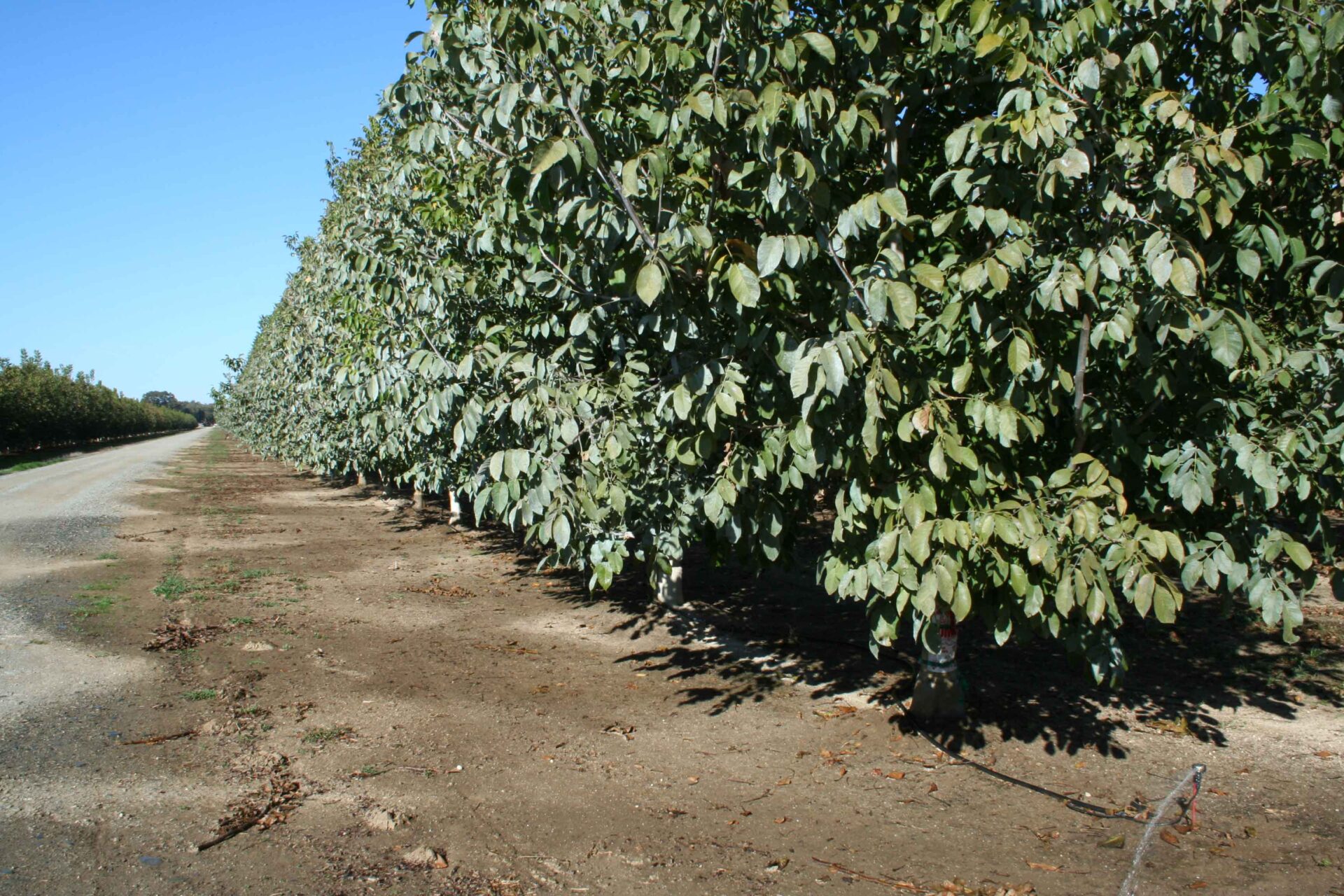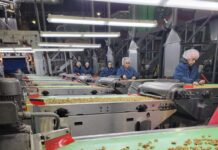Because of looming state regulations meant to protect ground water sources from nitrate contamination, California growers are being asked to re-examine how the amount of nitrogen (N) they apply compares with the amount they remove from their fields. Walnut growers are no exception. In order to use this nutrient more efficiently, growers and orchard managers may need to recalculate their application rates. Cost of over application is also a concern for growers.
Ongoing research by University of California (UC) and University of California Cooperative Extension (UCCE) farm advisors, funded by the California Department of Food and Agriculture (CDFA) and the California Walnut Research Board, aims to more closely quantify the timing and scale of nutrient needs on typical soils to produce high yields. California walnut producers need to apply the nitrogen portion of their nutrients efficiently to reduce nitrate leaching below the root zone, and make sure their trees receive needed nutrition, said UCCE orchard systems advisor Katherine Jarvis-Shean in Yolo County.
Research done in the 1990s gave growers a figure of 40 pounds of N removed per ton of walnuts. Recent research that is still being finalized shows that walnut orchards accumulate closer to 30 pounds of N per ton of harvested nuts. Jarvis-Shean said the middle of 30-40 pound range is more accurate than 40 pounds per ton. Since yields are dependent on nitrogen supply, Jarvis-Shean said studies would continue to determine the number. For now, she said 40 pounds would remain the official number when calculating N removal.
Of the macro nutrients, nitrogen accumulation in walnuts is fairly steady over the growing season. Phosphorous accumulation is also steady through most of the growing season, but tapers off in September. Potassium use is steady until September when significant amounts of this nutrient are left in the orchard in hulls.
Phosphorus accumulation for every harvested ton ranged from 3.3 to 4.8 pounds. Potassium accumulation for every harvested ton ranged from 11.6 to 50.8 pounds.
The research study also included improved sampling techniques for orchard nitrogen status and noted that early season nitrogen status is a very strong indicator of midsummer nitrogen status.
Three Rs of Nutrition
The standard Right Rate, Right Time, Right Place and Right Source practices remain valuable guidelines for applying macro nutrients for walnut production. Amount (“rate”) and timing need to match tree demand to optimize efficient uptake.
When timing or amount of supply doesn’t match demand—when too much is applied, or too much at one time—nitrogen can leach from the root zone into groundwater. To date, Jarvis-Shean’s research has reported that on average, 29 pounds of N are found in every ton of walnuts in shell from mature orchards. Roughly another five to ten pounds comes off in hulls, leaves and debris or is dedicated to new growth, depending on the year and age of the trees.
Applications of nitrogen fertilizer, Jarvis-Shean said, are best done when trees have actively growing roots, except in the first month after leaf-out, when the tree draws nitrogen from in-tree storage. For most varieties, this means applying May through August. Water, oxygen and seasonal temperatures are also necessary. Nitrogen use by walnut trees during those months is steady. Determining rate of applied nitrogen is best done based on anticipated yield, which is based on set, conditions during flowering, age of the orchard and previous orchard yields. Nitrogen content of irrigation water and organic matter left from cover crops or compost applications should be counted.
Midsummer leaf samples can be taken to make sure applications are keeping up with demand. It is highly unlikely that trees would become nitrogen deficient in one season. Tracking July leaf nitrogen over many seasons will show trends of whether sufficient nitrogen in being taken up by the trees to meet the demand, or if a change in nitrogen management is necessary.
The right timing is critical in supplying the nutrient when trees need it most. It also decreases risk of nitrate leaching below the root zone. Roots must be active and growing. Jarvis-Shean said growers have traditionally made two applications in May and July. Four applications divided over the growing season will increase nitrogen use efficiency. Nitrogen can only be taken up when there are leaves on the tree and the first month of growth uses stored N.
For trees to take up nitrogen, it needs to remain in the root zone. Although walnuts are deep rooted in certain soils, most of the root activity is in the top three feet of the soil. Managing irrigation to decrease leaching of N below the root zone keeps this nutrient were it can be used by the tree. Nitrogen applications being done with fertigation—a ‘spoon-fed” approach that delivers small amounts of nutrients over time also can increase efficiency. Fertigation should be done during the last half or third of an irrigation set.
As for source, a grower’s choice is generally influenced more by price as there is no difference in yield between equal amounts of N as UAN 32 or CAN-17.
The most common source of nitrogen are the synthetic fertilizers; urea (45 percent), urea-ammonium nitrate (32 percent N), ammonium nitrate (34 percent N), ammonium sulfate (21 percent N), calcium-ammonium nitrate (17 percent N), and calcium nitrate (15 percent N). Organic sources include manures, cover crops and/or organic fertilizer products.
Losses of N through the root zone vary with the type of fertilizer, method of irrigation, and soil type. The highest recovery is in clay loam soil applied by fertigation through microsprinklers or drip. The lowest recovery occurs in sandy loam soil with broadcast application, no incorporation and flood irrigation. Jarvis-Shean said all types of N, including N in compost, can eventually transform into nitrate, which can leach below the root zone.
Orchard site and management matter more than the cultivar when it comes to N use, Jarvis-Shean noted.
She said leaf sampling is becoming more common as growers want to determine nutrient status to make sure nutrient applications are cost effective. With the added concern of groundwater protection regulations, more growers are using leaf sampling in addition to yield estimates to avoid over applying nitrogen.
Soil tests can provide background information on soil physical and chemical characteristics including cation exchange capacity, organic matter and salinity.
Growers who would like to know more about nut orchard management including nutrition and fertilization may sign up for a nine day course being offered by UC Davis Feb. 19-March 1. Five days of classroom instruction is followed by four days of farm tours in northern and central California.
For course content questions, please contact Carlos Crisosto, Director, Fruit & Nut Research and Information Center (chcrisosto@ucdavis.edu).












